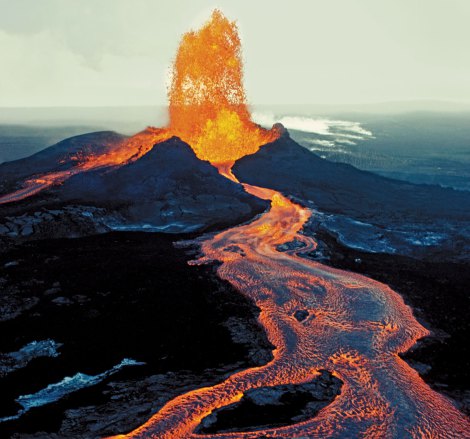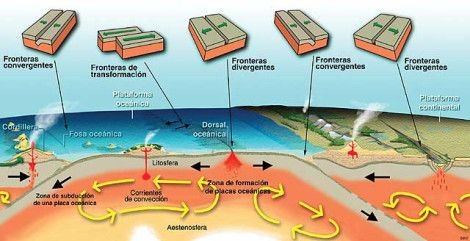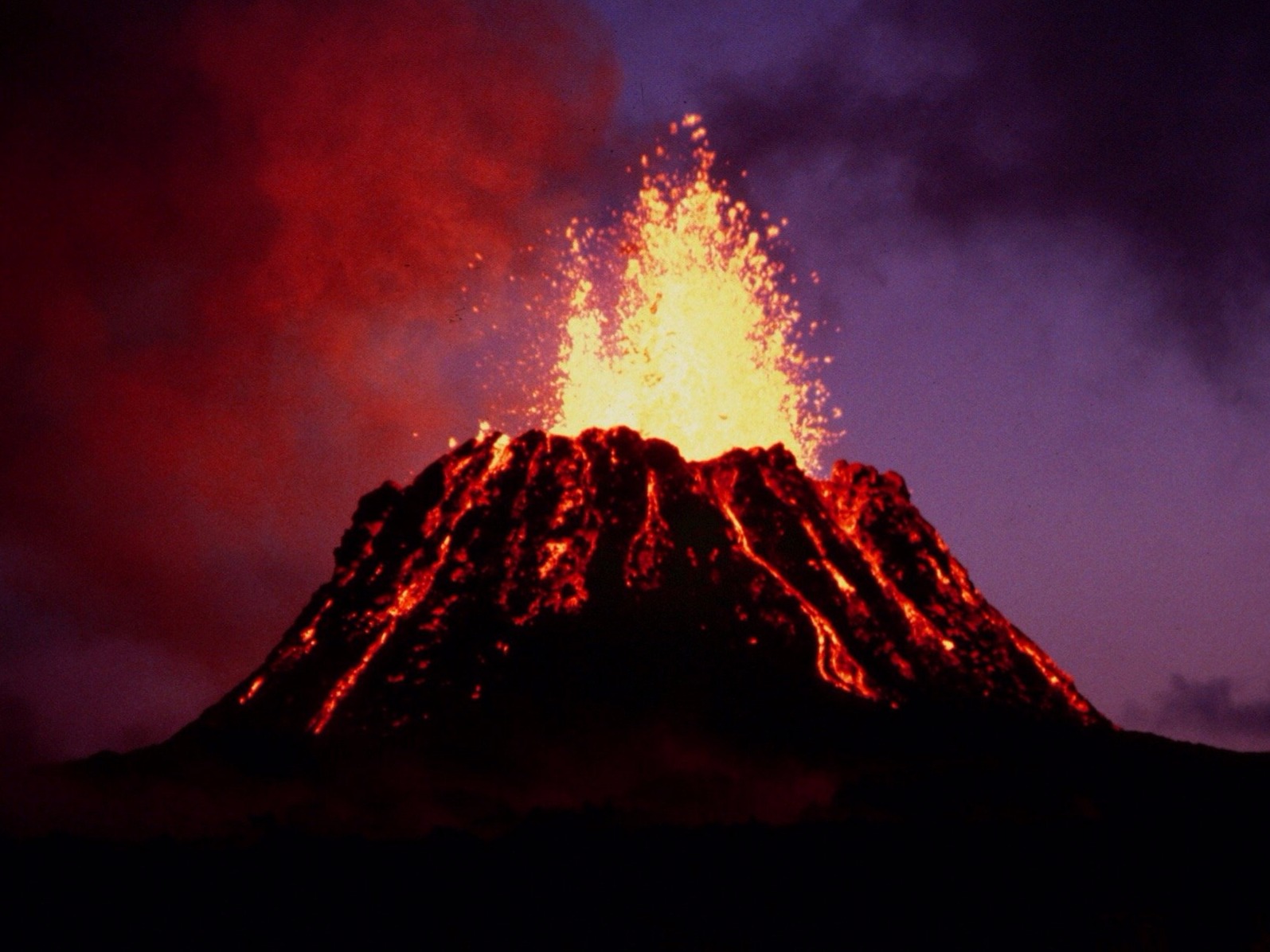The volcanoes
Volcanoes can be found on earth as well as on other planets and satellites, some of which are made of materials that we consider "cold"; These are cryovolcanoes. That is to say, in them the ice acts as a rock while the cold internal liquid water acts like magma.
In general, volcanoes are formed in the limits of tectonic plates, although there are exceptions called hot spots or hot spots located inside tectonic plates, as is the case of the Hawaiian Islands. There are also underwater volcanoes that can expel enough material to form volcanic islands. They originate by the influence of a bag of magma inside the Earth. The magma bag looks for cracks to go outside. When the magma explodes, it becomes what we call lava. When the lava is coming out, with the sudden change in temperature it solidifies. Each time the lava goes outside and solidifies, the volcanic cone increases.
Volcanoes are a surface manifestation of the Earth's internal energy. The temperature and pressure increase as we approach the center of the Earth, reaching temperatures of 5000 ºC in the core. The combined effect of temperature and pressure at different depths causes a different behavior of materials that are structured in several layers:

The bark, cold and very rigid, is the outer layer.
The mantle, with temperatures higher than 1000 ºC, presents a semi-rigid behavior. In the upper levels is where the magmas originate by partial fusion of the rocks that are there. In the lower mantle (asthenosphere), the materials move slowly due to the convection currents caused by the temperature differences between the upper part and the core, causing the movement of the tectonic plates.
The core is the innermost and densest part of the Earth. It is found at a temperature close to 5000ºC. Due to this high temperature, the materials behave like a liquid (external core); however, in the deepest zone they are in solid form due to the very high pressure they support.
current internal structure of the Earth has been forming as the planet has aged and cooled. Initially, the entire surface was constituted by molten materials, which have been solidifying over the course of billions of years. The current volcanic activity is just a rest of this process.

A volcano is a geological formation that consists of a fissure in the earth's crust on which a cone of volcanic matter accumulates. At the top of the cone there is a concave chimney called a crater. The cone is formed by the deposition of molten and solid matter that flows or is expelled through the chimney from the interior of the Earth. It is a conduit that establishes direct communication between the terrestrial surface and the deep levels of the earth's crust and that every certain period of time, they expel lava, gases, ash and smoke coming from the interior of the Earth. The study of volcanoes and volcanic phenomena is called volcanology.
In a somewhat more formal way the definition of MacDonald (1972) can be used and it can be said that a volcano is that place where the molten rock or fragmented by heat and hot gases emerge through an opening from the internal parts of the earth to the surface.
The geographical location of Los Volcanes
The geographic location of the current volcanoes is related to the division into plates of the earth's crust. As the surface of the Earth cooled, solid areas of light materials appeared floating on top of others still melted. These solid zones gave rise to the first continental masses that are dragged by convection currents from the interior of the Earth. Over time, these continental masses have been growing, decreasing convection currents and increasing the rigidity of the outer layers as the Earth cooled.
At present, the surface of the Earth is divided into blocks, called tectonic plates, which continue to move at different speeds (several centimeters per year). At the edges of these plates is where the external manifestations of the activity of the interior of the Earth are concentrated; orogenic processes (folds and faults), volcanoes and earthquakes. These edges can be convergent, divergent and transient.
At the converging edges, one of the plates is introduced under the other in a process called subduction, which gives rise to intense seismic activity and magmas, which can go outside, forming characteristic volcanic zones (Los Andes, Japan). The heavier oceanic crust sinks beneath the lighter continental crust. This is dragged on an oblique path into the Earth's interior until it reaches a depth in which it melts. It then ascends through vertical cracks and is expelled to the surface by a volcanic chimney. The relative movement of both plates gives rise to shallow and deep earthquakes.

Parts of a volcano
No volcano is identical to any other, as some have barely erupted, while others maintain a constant stream of lava, as is the case with the Hawaiian volcano. However, the general characteristics of every volcano are the following:
Volcanic cone: formed by the same pressure of the magma to ascend) is cone shaped and is formed by solidified lava and ash.
Boiler: depression caused by the collapse of the magma chamber.
Magmatic chamber: a bag that is inside the Earth formed by minerals and rocks in a liquid state as a consequence of the very high temperatures and pressures.
Crater: eruption mouth of the volcano.
Parasitic crater: second lava flows.
Magma: multiphase mixture of solids, liquids and gas produced by the fusion between the base of the earth's crust and the upper part of the mantle.
Lava: magma that rises reaching the surface.
Central chimney: main road through which the magma rises.
Fumarole: gas emissions from the lavas in the craters.
Solfataras: are emissions of water vapor and hydrogen sulfide.
Skunks: they are cold fumaroles that give off carbon dioxide.
Geysers: small volcanoes of boiling water vapor.

Some volcanoes are much more active than others. It can be said that some are in a state of permanent eruption, at least in the geological present. The Stromboli, in the Lipari islands near Sicily, has been active since antiquity. The Izalco, in El Salvador, has remained active since its first eruption in 1770. Other active volcanoes are constantly found in a chain, called a belt or ring of fire, that surrounds the Pacific Ocean. Another volcanic mountain range extends over more than 1,000 km from Guatemala to Panama, with about 80 volcanoes; those who are active exceed thirty. It is estimated that in the Andes mountain range there are more than 60 that can be considered active.
Many other volcanoes, such as Vesuvius, remain in a state of moderate activity for longer or shorter periods and then remain at rest, or asleep, for months or years. El Atitlán, in Guatemala, was active about 300 years before 1843; since then it is inactive. The eruption that happens to a period of prolonged latency is usually violent, like the one of the Saint Helens mount of the state of Washington (the United States) in 1980, after 123 years of inactivity. The eruption of Mount Pinatubo in the Philippines during the month of June 1991 came after six centuries of dormancy.
The threat to all forms of life represented by active volcanoes is not reduced to the eruption of molten rock or the rain of ash and embers. The mud currents are also a serious danger. It is estimated that one of them, unleashed in 1985 by the eruption that melted ice and snow on the Nevado del Ruiz volcano in Colombia, produced more than 25,000 deaths.
When there is no record of the eruptive activity of a volcano, specialists talk about inactive volcanoes. On the other hand, the volcanoes that were active not too long ago or that, currently, continue with eruptive activity, are called active volcanoes.

The eruption
The magma rises through the chimney and flows into lava over the edge of the crater, or oozes, like a doughy mass, through fissures in the slope of the cone. This may indicate what has been called "crisis" or crucial point of the eruption; After the final ejection of fragmented matter, the volcano can return to the dormant state.
In a violent eruption of a volcano, the lava is very laden with steam and other gases, such as carbon dioxide, hydrogen, carbon monoxide and sulfur dioxide, which escape from the lava mass with violent explosions and rise to form a cloud cloudy These clouds discharge, many times, copious rains. Large and small portions of lava are expelled to the outside, and form a hot source of drops and fragments classified as bombs, embers or ashes, according to their sizes and shapes. These objects or particles fall on the outer slopes of the cone or on the inside of the crater, from where they are expelled again and again. Lightning can also appear in clouds, especially if they are heavily loaded with dust particles.
The enormous amount of energy released during an explosive eruption can be evaluated according to the height to which the rocks and ashes are projected. There are reports that the ashes of the Krakatoa, in Indonesia, were dragged up to a height of 27 km when the volcano erupted in 1883. The clouds of steam and dust thus produced can have long-lasting atmospheric and climatic effects.
I hope you like this information
References for more information
http://education.seattlepi.com/happens-temperature-pressure-closer-earths-core-4961.html
http://a8creative.co.uk/indonesia-adventure/volcanoesencarta.htm

You received a 10.0% upvote since you are not yet a member of geopolis.
To read more about us and what we do, click here.
https://steemit.com/geopolis/@geopolis/geopolis-the-community-for-global-sciences-update-3
If you do not want us to upvote and comment on your posts concerning earth and earth sciences, please reply stop to this comment and we will no longer bother you with our love ❤️